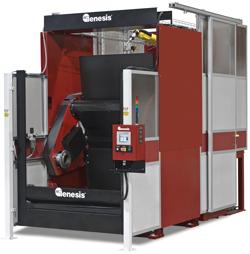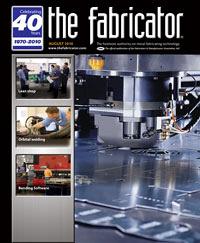Process Engineering Manager
- FMA
- The Fabricator
- FABTECH
- Canadian Metalworking
Categories
- Additive Manufacturing
- Aluminum Welding
- Arc Welding
- Assembly and Joining
- Automation and Robotics
- Bending and Forming
- Consumables
- Cutting and Weld Prep
- Electric Vehicles
- En Español
- Finishing
- Hydroforming
- Laser Cutting
- Laser Welding
- Machining
- Manufacturing Software
- Materials Handling
- Metals/Materials
- Oxyfuel Cutting
- Plasma Cutting
- Power Tools
- Punching and Other Holemaking
- Roll Forming
- Safety
- Sawing
- Shearing
- Shop Management
- Testing and Measuring
- Tube and Pipe Fabrication
- Tube and Pipe Production
- Waterjet Cutting
Industry Directory
Webcasts
Podcasts
FAB 40
Advertise
Subscribe
Account Login
Search
Making the case for robotic welding
Consider the costs—and cost savings—before setting up a robotic welding cell
- By Mike Jacobsen
- August 4, 2010
- Article
- Automation and Robotics

: Figure 1: The American Welding Society contends that the average age of a welder is 55, with many approaching 60 years old. With so many welders on the verge of leaving the work force, many fabricators are looking seriously at robotic welding for certain applications.
In today’s stagnant economy and competitive international marketplace, many manufacturers must find ways to match or surpass their competition, reduce costs, increase their bottom line, and continue to produce quality parts consistently. As a result, many manufacturers are either implementing automation or are considering upgrading their current automation systems.
Although such a decision may feel like a risky venture, this may be the ideal time to revamp and revitalize your factory process. After all, you are talking about increasing employee productivity without adding employees (see Figure 1).
While implementing automation may sound like a good plan, the million-dollar question is, How do I determine the payback for this substantial capital investment? Also ask yourself, What costs can be reduced by implementing this system? What are the upfront costs? How do we justify the start-up expense? and When will the investment begin paying for itself?
But before you can address the questions of cost, you need to determine the right system for your operation. How do you know which manufacturing processes will benefit from automation? Who can help you determine the type of system you need and how to integrate it into your manufacturing process?
Assess the Situation Before Automating
First, don’t even consider trying to answer these questions yourself. Because the decision to automate a welding process affects many employees and departments differently, it is a good idea to take a team approach and get input and consensus from the employees, managers, and outside automation experts.
Automation experts can rely on their past experiences to assess your situation. Not all welding manufacturing processes are conducive to automation. In the past robotic welding was considered applicable for only high-volume/low-mix production. However, with today’s latest technology and rapid part changeovers, fabricators that produce a variety of parts may be able to utilize low-volume/high-mix automation efficiently.
Those same experts can take a look at a part design and the production process to determine if they are feasible for automation. They also will be able to determine if a part can be designed better for automation or how an automated welding cell can be altered to accommodate inconsistent parts.
Determine the Costs
Actually, the parts that are candidates for an automated welding cell drive a lot of the potential investment cost. For example, if the parts and weld joints are not consistently in the same position, it will be necessary to add touch sensing or vision capabilities to the welding robot so it can locate the joints. This adds to the initial cost and adds to the time it takes to weld each part. If you want to run more than one part on the system, you will need to incorporate changeover features.
In addition, whether you are manufacturing your own parts or getting them from a supplier, they must be produced in a timely manner to get the most out of your investment. You don’t want the robot to have to wait for parts. Will you need to consider pulling some outsourced manufacturing activities in-house to keep the automated welding cell going?
The automation obviously will take care of the welding, but will you need a robot to move material in and out of the cell or rely on the operator to move the material (see Figure 2)? Fixtures are another expense, but may not be a large one for those companies that can fabricate them internally.

: Figure 2: Many robotic cells still require someone to load and unload parts. Labor costs are reduced, however, because a company doesn’t have to pay a welder to move the material.
You need to consider the amount of floor space that the automated welding system and related safety barriers will require. Once again, the parts to be welded in the cell influence this decision greatly, because just how far the welding torch will need to reach determines the system’s operational envelope.
Finally, don’t take the human factor out of the automation equation. One of the bottom-line questions when assessing automation is how implementing this system will impact your work force. Will retraining be necessary so current employees can operate the system or perform other jobs? If so, what are the costs and payback? Is your staff capable and willing to be retrained?
Discover the Cost Benefits
When justifying your automation investment, many aspects factor into payback. Finding concrete answers to the following questions can help you prepare a strong case for a solid return on investment.
How much labor is tied up in manual welding of parts that might be done automatically? Manual welding costs are high, and good welders are difficult to find, train, and retain. Chart your wage and benefit costs, and project them over time to justify your investment. Also realize that employees might be candidates to be redeployed to other areas of production.
How long does it take to weld my parts robotically compared to manually welding them? How does this affect my production yield and labor needs? An automation expert should be able to determine these numbers for you and calculate them over time to support the case for an investment.
How much labor is tied up in postweld cleanup? With the consistency of a robotic welding system, you can expect less weld spatter and neater seams.
What is the current scrap rate for parts that are candidates to be welded automatically? Better welds result in fewer rejected parts and scrap. A robotically welded part is the same each and every time. There are no variances from week to week, day to day, shift to shift, or part to part.
How much welding wire is consumed in manual welding of parts that might be done automatically? An automated system uses the filler material more economically, resulting in less waste. This can lower material costs.
How much downtime is the shop floor experiencing because of excessive changeover time and other activities that delay the welding arc from being struck? Time is money, and an automated welding cell increases uptime as long as parts are being fed into it. In a way, automation results in increased part production with shorter delivery times. Your product reaches the market faster.
What are the costs associated with the inability to respond to ever-changing customer demands? If an automated welding system includes the correct changeover system, flexible tooling, robot vision, and touch sensing to take on different parts in easily changeable configurations, you can respond to production demands more efficiently and economically.
Manual welding is a dangerous job that exposes employees to flash, sparks, fumes, and, in some cases, toxic gases. An automated system minimizes human contact with those dangerous aspects of the job. In fact, a robotic welding cell actually may reduce insurance costs and workers’ compensation claims.
These are just a few of the things to consider when determining the cost and payback of a robotic automation system. It is not a decision that is made lightly, nor is it one to be made alone. It takes a team effort to determine the need, develop the system, implement the production, monitor the results, and maintain a cost-effective system.
Answering all of these questions may seem like a long, arduous task, but taking the time to properly research and prepare for robotic automation can pay off in the end.
About the Author
Mike Jacobsen
8900 Harrison St.
Davenport, IA 52806
563-445-5600
Related Companies
subscribe now

The Fabricator is North America's leading magazine for the metal forming and fabricating industry. The magazine delivers the news, technical articles, and case histories that enable fabricators to do their jobs more efficiently. The Fabricator has served the industry since 1970.
start your free subscription- Stay connected from anywhere

Easily access valuable industry resources now with full access to the digital edition of The Fabricator.

Easily access valuable industry resources now with full access to the digital edition of The Welder.

Easily access valuable industry resources now with full access to the digital edition of The Tube and Pipe Journal.
- Podcasting
- Podcast:
- The Fabricator Podcast
- Published:
- 04/16/2024
- Running Time:
- 63:29
In this episode of The Fabricator Podcast, Caleb Chamberlain, co-founder and CEO of OSH Cut, discusses his company’s...
- Industry Events
16th Annual Safety Conference
- April 30 - May 1, 2024
- Elgin,
Pipe and Tube Conference
- May 21 - 22, 2024
- Omaha, NE
World-Class Roll Forming Workshop
- June 5 - 6, 2024
- Louisville, KY
Advanced Laser Application Workshop
- June 25 - 27, 2024
- Novi, MI































